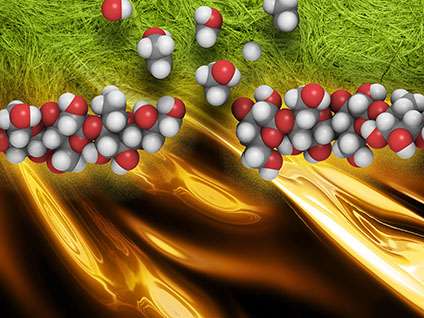Enzyme shows promise for efficiently converting plant biomass to biofuels

To make biofuels, tiny microbes can be used to break down plant cells. As part of that digestive process, specialized enzymes break down cellulose—a major molecule that makes plant cell walls rigid. Scientists showed that an enzyme, from the bacterial glycoside hydrolase family 12, plays an unexpectedly important role in breaking down a hard-to-degrade crystalline form of cellulose. Surprisingly, the enzyme breaks apart the cellulose via a random mechanism unlike other hydrolases.
Breaking down cellulose is a major challenge in developing more efficient strategies for converting plant biomass to fuels and chemicals. The discovery of a specialized enzyme that is highly effective at breaking down rigid plant cell wall components could be harnessed to solve this challenge.
Microbes such as fungi and bacteria produce enzymes, called glycoside hydrolases, to acquire nutrients through the degradation of cellulose—carbohydrates that make up plant cell walls. Some of these enzymes can break down the rigid, crystalline form of cellulose and, therefore, could be especially effective at converting tough plant biomass to fuels and chemicals. However, scientists have largely studied these enzymes in pure cultures of microorganisms, even though microorganisms break down cellulose as communities in the environment.
To address this knowledge gap, a multi-institutional team of researchers led by scientists at the U.S. Department of Energy's (DOE) Joint BioEnergy Institute (JBEI) combined comparative proteomics with biochemical measurements. They then assessed differences in glycoside hydrolases produced by diverse microbes in communities cultivated from green waste compost and grown on crystalline cellulose. The team used several mass spectrometry instruments at EMSL, the Environmental Molecular Sciences Laboratory, and high-throughput DNA sequencing technologies at the DOE Joint Genome Institute, both of which are DOE Office of Science user facilities.
Their analysis revealed that a glycoside hydrolase family 12 enzyme, produced by the bacterium Thermobispora bispora, plays a previously underappreciated role in breaking down crystalline cellulose. The new findings suggest this enzyme could be especially effective at converting plant biomass to fuels and chemicals. More broadly, the study illustrates the power of comparative community proteomics to reveal novel insights into microbial enzymes that scientists could harness for fuel production from renewable energy sources.
More information: Jennifer Hiras et al. Comparative Community Proteomics Demonstrates the Unexpected Importance of Actinobacterial Glycoside Hydrolase Family 12 Protein for Crystalline Cellulose Hydrolysis, mBio (2016). DOI: 10.1128/mBio.01106-16
Journal information: mBio
Provided by US Department of Energy




















